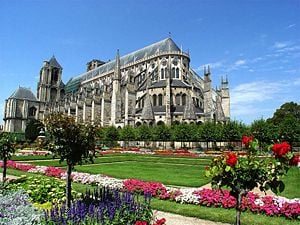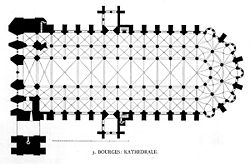Difference between revisions of "Bourges Cathedral" - New World Encyclopedia
David Doose (talk | contribs) m |
David Doose (talk | contribs) m (→References) |
||
| Line 40: | Line 40: | ||
==References== | ==References== | ||
| + | *Bayard, Tania. 1976. ''Bourges Cathedral: The West Portals.'' Outstanding dissertations in the fine arts. New York: Garland. ISBN 0824019776 | ||
| + | *Branner, Robert, and Shirley Prager Branner. 1989. ''The Cathedral of Bourges and its place in Gothic Architecture.'' Architectural History Foundation books. New York, N.Y.: Architectural History Foundation. ISBN 0262022761 | ||
| + | *Pryce, Will. 2008. ''World Architecture: The Masterworks.'' (London): Thames & Hudson. ISBN 9780500342480 | ||
==External links== | ==External links== | ||
Revision as of 02:30, 15 April 2009
| Bourges Cathedral* | |
|---|---|
| UNESCO World Heritage Site | |

| |
| State Party | |
| Type | Cultural |
| Criteria | i, iv |
| Reference | 635 |
| Region** | Europe and North America |
| Inscription history | |
| Inscription | 1992 (16th Session) |
| * Name as inscribed on World Heritage List. ** Region as classified by UNESCO. | |
Bourges Cathedral (Cathédrale Saint-Étienne de Bourges) is a cathedral, dedicated to Saint Stephen, located in Bourges, France. It is the seat of the Archbishop of Bourges.
History
Construction of Bourges Cathedral began in 1195, the same time as Chartres Cathedral. The choir was completed by 1214 and the nave was completed in 1225-1250. The west façade was finished in 1270. The architect was Paul-Louis Boeswillwald and the master builder was Philip Berruyer.
The cathedral is the burial place of William of Donjeon (c. 1155 - January 10, 1209), who was Archbishop of Bourges from 1200 until 1209.
The cathedral was added to the list of the World Heritage Sites by UNESCO in 1992.
Dimensions and structure
The cathedral's nave is 15m wide by 37m high; its arcade is 20m high; the inner aisle is 21.3m and the outer aisle is 9.3m high. The use of flying buttresses was employed to help the structure of the building. However, since this was a fairly new technique, one can easily see the walls were still made quite thick to take the force. Sexpartite vaults are used to span the nave.
Notable features
Bourges is notable for the unity of its design, seen in no other cathedral of the High Gothic era. It features two distinct horseshoe aisles that wrap around a central nave and choir). The inner aisle has a higher vault than the outer aisle.[1] Each ambulatory/aisle has its own portal at the west end. The five portal entrance necessitated more careful design to create a more coherent façade. This also eliminated the usual cross-shaped transept design.[2] The gallery is absent; instead the inner aisle has been raised. This gives the cathedral a pyramidal shape under the buttresses. The flying buttresses are very structurally efficient (particularly compared to those at Chartres, which is a contemporary structure) as the steep angle channels the thrust from the nave vaults and from wind loading more directly to the outer buttress piers.
The Great Tower is a copy of one found at the Louvre and symbolizes royal power. The statues on the façade smile at the tympanum of the Last Judgment, welcoming the Judgment of Christ. The Romanesque carved portals from about 1160-70, probably intended for the facade of the earlier cathedral, have been reused on the south and north doors. The profuse ornamentation is reminiscent of Burgundian work.
Bourges Cathedral retains almost all its original ambulatory glass (apart from the axial chapel), dating from about 1215. The iconography used in many of these windows uses typology (such as Old Testament episodes prefiguring events in the life of Christ) and symbolism (such as the pelican who pecks her breast to feed her young on her own blood and the lioness who licks the malformed cub into shape) to communicate theological messages. Other windows show the parables of the Good Samaritan and the Prodigal Son, the story of Dives and Lazarus, and the Apocalypse.
Notes
- ↑ Bony, Jean (1985). French Gothic Architecture of the Twelfth and Thirteenth Centuries, p. 212. University of California Press. ISBN 0520055861.
- ↑ Marshall, Herbert Menzies, and Marshall, Hester (1907). Cathedral Cities of France, p. 160. London: William Heinemann.
ReferencesISBN links support NWE through referral fees
- Bayard, Tania. 1976. Bourges Cathedral: The West Portals. Outstanding dissertations in the fine arts. New York: Garland. ISBN 0824019776
- Branner, Robert, and Shirley Prager Branner. 1989. The Cathedral of Bourges and its place in Gothic Architecture. Architectural History Foundation books. New York, N.Y.: Architectural History Foundation. ISBN 0262022761
- Pryce, Will. 2008. World Architecture: The Masterworks. (London): Thames & Hudson. ISBN 9780500342480
External links
- Sacred Destinations: Bourges Cathedral
- History of Gothic Architecture: Bourges
- Bourges Cathedral at UNESCO World Heritage
- City of Bourges: Saint-Etienne cathedral
Coordinates:
Credits
New World Encyclopedia writers and editors rewrote and completed the Wikipedia article in accordance with New World Encyclopedia standards. This article abides by terms of the Creative Commons CC-by-sa 3.0 License (CC-by-sa), which may be used and disseminated with proper attribution. Credit is due under the terms of this license that can reference both the New World Encyclopedia contributors and the selfless volunteer contributors of the Wikimedia Foundation. To cite this article click here for a list of acceptable citing formats.The history of earlier contributions by wikipedians is accessible to researchers here:
The history of this article since it was imported to New World Encyclopedia:
Note: Some restrictions may apply to use of individual images which are separately licensed.

